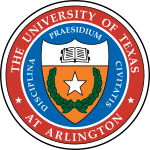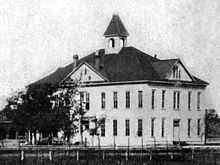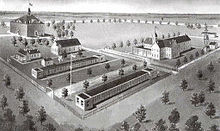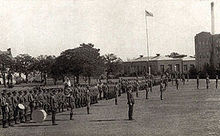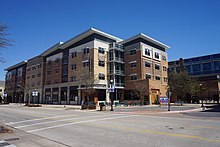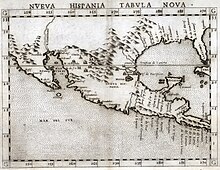
The University of Texas System is a public university system in the U.S. state of Texas. It includes nine universities and five independent health institutions. The UT System is headquartered in Downtown Austin. It is the largest university system in Texas with 250,000+ enrolled students, 21,000+ employed faculty, 83,000+ health care professionals, researchers and support staff. The UT System's $42.7 billion endowment is the largest of any public university system in the United States.
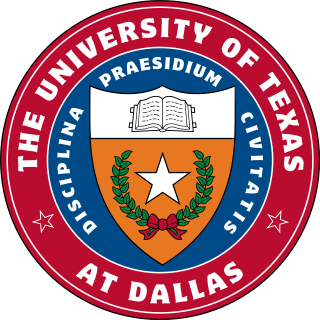
The University of Texas at Dallas is a public research university in Richardson, Texas. It is the northernmost institution of the University of Texas System. It was initially founded in 1961 as a private research arm of Texas Instruments.

Nedderman Hall is an academic engineering building located on the University of Texas at Arlington campus. The building houses the Civil Engineering and Electrical Engineering departments, lecture halls, research labs, the offices of the Dean of the College of Engineering, and a Science and Engineering library.
The Shorthorn is the campus newspaper for the University of Texas at Arlington. It is published online daily with a print digest on Wednesday during the fall and spring semesters. During the summer, all content is published online since no print edition is produced.

Wendell Herman Nedderman was an American academic administrator who was president of the University of Texas at Arlington for nearly 20 years, first as acting president, then as president, leaving that post in July 1992. He began his 33 years of full-time service at UT Arlington in 1959 as the founding dean of the College of Engineering. This was followed by four years as vice president for academic affairs, and then 20 years as president. A campus engineering building was named Nedderman Hall in 1991 by the UT System board of regents. Campus Street and a portion of Monroe Street were combined and named Nedderman Drive by the City of Arlington in 1992. He was named president emeritus in 1992, and received the Mirabeau B. Lamar Award for Leadership in Learning from the Association of Texas Colleges and Universities. He was awarded the Anson Marston Medal for Achievement in the Field of Engineering in 2000 from Iowa State University.

Jack Royce Woolf was an American academic who arrived at Arlington State College in 1957 as dean of the college. After one year as dean, the Texas A&M Board appointed him acting president in 1958 and president in 1959. In 1967, upon the university leaving the Texas A&M System for the University of Texas System and with the accompanying name change, Woolf became president of The University of Texas at Arlington. Woolf resigned the presidency in 1968, but continued service to the university until 1989.

Maverick Stadium is a 12,000-seat multi-purpose stadium on the western edge of University of Texas at Arlington campus.

The UT Arlington Mavericks are the athletic teams that represent the University of Texas at Arlington in Arlington, Texas. The Mavericks currently compete in the NCAA Division I Western Athletic Conference in 15 varsity sports. The number rose to 15 in the fall of 2017 women's golf began their first season of competition that athletic season.
The Texas–Arlington Mavericks football team represented the University of Texas at Arlington from the 1959 through 1985 season. Between 1919 through 1958, UTA competed as a junior college prior to moving to the NCAA College Division in 1959 and ultimately the University Division in 1971. UTA played its home games at multiple stadiums throughout their history with the most recent being Maverick Stadium, in Arlington, Texas.

College Park Center (CPC) is an indoor, multi-purpose arena on the University of Texas at Arlington campus in Arlington, Texas, United States. It seats up to 7,000 spectators.
The University of Texas at Arlington (UTA) College of Engineering is a college of engineering at the University of Texas at Arlington in Arlington, Texas. The engineering program was established in 1959 when Arlington State College was officially given the status of a senior college. The college currently offers 11 baccalaureate, 14 master's, and nine doctoral degrees. The College of Engineering celebrated its 50th anniversary in 2009 and is the third largest engineering program in Texas.

Frank Harrison Jr. was an American physician, professor and university administrator.
Vistasp Karbhari is an Indian-American civil engineer and university administrator. Karbhari was the eighth president of the University of Texas at Arlington. Prior to that, he was provost and executive vice president for academic affairs at the University of Alabama in Huntsville. He is known for his research in composite materials and structural engineering.

The Center for Mexican American Studies at The University of Texas at Arlington is an academic research center that promotes research and the recruitment, retention, and professional development of UTA faculty actively engaged in studies on Latino issues.

Ernest 'H' Hereford was Dean of North Texas Agricultural College from 1946–49, when the school was renamed Arlington State College he served as President from 1949 until his death in 1958. The college would later become the University of Texas at Arlington in 1965. His tenure included the expansion of the school system, the changing nature of the school away from primarily-agricultural studies, Cold War-era "Citizenship classes" being promoted via the state government, as well as the spearheading the change of the school theme from 'Blue Riders' to the 'Rebels' in 1951.

The history of the University of Texas at Arlington began with the foundation of Arlington College in 1895, which was the first of a series of private schools to exist on the site of the present university. Created largely due to the underfunded and generally inadequate public schools in the city, it closed in July 1902 after Arlington voters passed a proposition to create an independent school district. Carlisle Military Academy was established on the same site by Colonel James M. Carlisle in 1902. It was molded by Carlisle's educational philosophy, which balanced intellectualism with military training. Carlisle's financial problems resulted in the school entering receivership in 1911, and in 1913 the school closed. In September 1913, Arlington Training School was founded by H. K. Taylor. The school was beset by financial troubles and lawsuits, ultimately closing after the 1915–16 academic year. In 1916, Arlington Military Academy was founded by John B. Dodson, and it lasted for only one academic year.

From 1917 to 1965, what is now the University of Texas at Arlington was a member of the Texas A&M University System. In March 1917, it was organized as Grubbs Vocational College (GVC), a junior college that was a branch campus of the Agricultural and Mechanical College of Texas (AMC), which later became Texas A&M University. Open only to white students, the curriculum at GVC centered around the agricultural, industrial, and mechanical trades.

In April 1965, the Texas Legislature transferred Arlington State College (ASC) from the Texas A&M University System to the University of Texas System. The following year, Maxwell Scarlett was the first African-American graduate in ASC history. In March 1967, ASC was renamed the University of Texas at Arlington (UTA). Jack Woolf, president of ASC and UTA since 1959, resigned in 1968 and was succeeded by Frank Harrison; Harrison was president until 1972. UTA awarded its first master's degrees in 1968, all in engineering. Reby Cary, the university's first African-American administrator, was hired the following year.

The UT Arlington Movin' Mavs men's wheelchair basketball team, previously known as the UTA Freewheelers, is the men's college wheelchair basketball team representing the University of Texas at Arlington (UTA). Established in 1976 as the UTA Freewheelers, the team played at the club level against other colleges and universities in Texas during the 1970s and 1980s. It has played under the auspices of the National Wheelchair Basketball Association (NWBA) since 1988, when the team was renamed the Movin' Mavs. Its inaugural coach, from 1976 until 2008, was Jim Hayes. The team was coached by Doug Garner from 2008 until 2022 when he retired. In fall of 2022, Aaron Gouge was hired as the new head coach for the team.
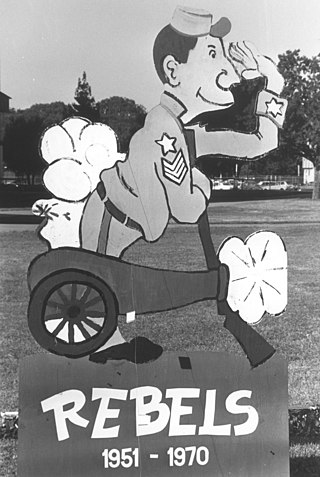
The University of Texas at Arlington (UTA) inherited a theme, including a nickname and mascot, of "Rebels" from its days as Arlington State College (ASC). The theme dated back to 1951, but after the integration of the school in 1962 and its admission into the University of Texas System in 1965, The Shorthorn student newspaper editorialized that it should be changed. Throughout the 1960s, editorials were written, protests were made, and referendums were held on the Rebel theme. However, with university president Frank Harrison consistently putting the decision fully in the control of UTA students, the student body repeatedly voted against changing the theme.
